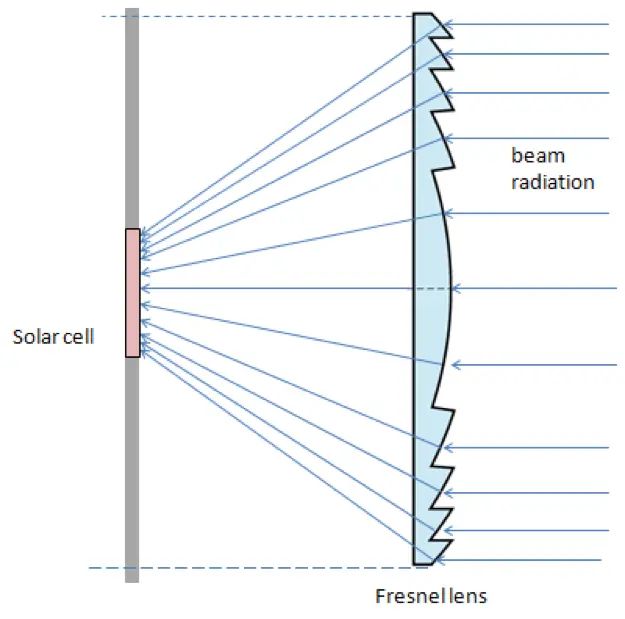cross-posted from: https://slrpnk.net/post/24690127
Solar energy experts in Germany are putting sun-catching cells under the magnifying glass with astounding results, according to multiple reports.
The Fraunhofer Institute for Solar Energy Systems team is perfecting the use of lenses to concentrate sunlight onto solar panels, reducing size and costs while increasing performance, Interesting Engineering and PV Magazine reported.
The “technology has the potential to contribute to the energy transition, facilitating the shift toward more sustainable and renewable energy sources by combining minimal carbon footprint and energy demand with low levelized cost of electricity,” the researchers wrote in a study published by the IEEE Journal of Photovoltaics.
The sun-catcher is called a micro-concentrating photovoltaic, or CPV, cell. The lens makes it different from standard solar panels that convert sunlight to energy with average efficiency rates around 20%, per MarketWatch. Fraunhofer’s improved CPV cell has an astounding 36% rate in ideal conditions and is made with lower-cost parts. It cuts semiconductor materials “by a factor of 1,300 and reduces module areas by 30% compared to current state-of-the-art CPV systems,” per IE.
Hey it’s those guys that invented MP3s.
It really whips the sun’s ass.
Just wanted to drop a comment.
I love solar. It’s the best form of energy that’s attainable by the average person.
I’m not sure what to think about the Fraunhofer institute in general. They have made some nice discoveries/inventions in the past, such as audio compression algorithms and such. That is why i hyped them for a bit.
But they really disappointed me with their writings on solar panels in the past few years.
They said that the efficiency of solar panels today is too low to deploy them widely in practice, which is simply not true. They tried pushing Perovskite solar cells for no reason.
I’m not sure what to think about this article’s idea. On one hand, adding lenses to solar parks makes them significantly more complicated and therefore expensive to build. Also, if the parks have complicated physical forms, they’re more susceptible to wind, and that could damage them.
On the other hand, yes, adding lenses means you need fewer actual solar panels for the same amount of energy harvested.
I’ll therefore put it in the category of inconclusive inventions, together with the idea of adding a motor to the solar panels so they can track the sun. That would also make the solar panels more efficient, but also more complicated and more prone to mechanical failure.
I’d like to know what they’re going to do about the heating issue. Concentrating solar radiation carries with it an increased heat load. And heat reduces solar PV efficiency. I’m already losing about 30% in summer when the panels heat up.
This was my first question too! I thought heat makes them wear out faster.
It does. Also seems weird nobody thought of a magnifying glass before.
But its also the beauty in science. Now somebody else thought about it, and they might work harder to fix the next problem: Heat.
If that gets better now, solar panels will increase in output even more. There are so many technologies going into one product, and each field have its own experts.
I’m excited.
I feel like this is one of those discoveries thats like, well duh of course it would work that way
Concentrating solar cells have been around for decades, but I suppose the efficiency Fraunhofer achieved here is nothing to sneeze at.
The only thing slowing down the transition from fossil fuels to renewables is the same impediment it has always been: oil money protecting itself.
Solar panels are already quite cheap. What we need is much cheaper grid forming inverters so we can stop destabilizing the grid with solar.
If the cost of panels drops significantly, there would be more capital available to spend on inverters, even if they stay at the current prices, still decreasing the cost of deployment. But yes. 😄
Grid forming will just mean the keep running the house when the power goes off, it’s not safe for them to be pushing power when it’s disappeared, that has been set by regulation in many countries.
What you describe is more like black start, providing power to the grind when it is down. This has to be controlled well, and only a few plants need to be capable of it.
Grid following means something like whatever the grid does, the inverter injects power supporting it. A grid forming generator or inverter also follows the grid somewhat, but tries to get it to an optimal condition. This entails things like voltage control by reactive power, frequency control by operating reserve, fault ride trough capability and so on. Many of those are naturally provided by large conventional power plants using synchronous generators like gas, nuclear or hydro. For inverter based systems, they have to be considered explicitly. For battery storage most are relatively easy to implement, some also in solar inverters. The tech exists, but yes, in some countries the regulations have not kept up with rapid expanse of inverter based power generation in the last years.
Wait for something fucking idiotic like:
“U.S. government to implement 5,000% tax on new solar technology…”
“also, revenue from new tax will be used to build new coal mines staffed by concentration camp inmates 1”
Solar is too woke and Marxist for the current US government.
Real men burn shit /s
What are concentrating photovoltaics? One of the ways to increase the output from the photovoltaic systems is to supply concentrated light onto the PV cells. This can be done by using optical light collectors, such as lenses or mirrors. The PV systems that use concentrated light are called concentrating photovoltaics (CPV). The CPV collect light from a larger area and concentrate it to a smaller area solar cell. This is illustrated in Figure 5.1.

Also, from the article - 33.6% efficiency in real-world conditions:
A 60 cell-lens prototype was studied for a year. In “real-world” conditions, CPVs achieved up to 33.6% efficiency. The 36% mark was posted at 167 degrees Fahrenheit. The prototype showed no signs of degradation, according to IE.
A lighthouse uses the same lens, just with the light coming from the inside. Since this is old knowledge, what is the drawback? Why isn’t this widespread?
My completely uninformed guess:
-
The lens and assembly costs too much compared to just more solar panels
-
The lens/panel combo is so bulky/prone to failure it becomes unreasonable to actually install/use.
Adding to what Eldest_Malk said: They aren’t just putting a new type of lens over standard solar cells, they are also designing/fabricating custom cells to work with the lenses. [I’m not a PV expert, but the fact that the IEEE paper focuses so much on the cells and not just the lenses leads me to believe that the lenses can’t just be used with whatever standardized solar cells are on the market]
id guess a lot went into designing a solar cell that could take being heated to 167F without losing efficiency or breaking. I think most common house solar panels have a temperature coefficient listed on their datasheet that measures how much its ability to generate power decreases per every degree above 77F
They mention standardisations and cost savings in their paper, as well as solving the heat load per cell problem by decreasing cell size. They also mention that there’s been a lot of micro-CPV module designs but that they haven’t been scaled up. Some quotes below:
Various researchers and developers have been exploring different micro-CPV module designs [5], [6], [7], [8], [9], [10], [11], [12], [13]. Most approaches have been tested on small prototypes or minimodules, while fewer have been realized with aperture areas (Aap) above 200 and 800 cm2,[…]
By decreasing the sizes of the primary optics and the solar cells, the heat load per cell is minimized. This reduction allows for sufficient heat spreading via the circuit board, enabling the direct assembly of solar cells onto the circuit board on glass.
At Fraunhofer ISE, we have developed a micro-CPV module concept [17], [18], [19], [20], [21], which is based on parallelized manufacturing processes and commercially available components.
The final module features a panel size of 24” × 18”, which is a standard in the microelectronics industry, facilitating machine adaption without necessitating special adjustments.
The article states that it’s smaller and cheaper. The reason it’s not widespread is that they just invented it.
It is interesting that someone just recently thought to use a fresnel lens with photovoltaics when they’ve existed for hundreds of years
It isn’t that. They have been talking about Fresnel lenses on PV for decades. It’s solving the heat issue and the size issue. A Fresnel lens gathers a large area of light and focuses it down, including focusing the heat. Normal PV cells cannot handle that amount of heat.
This is exactely how most inventions are made: put together two things from different realms that might have a good fit.
Just wait a few years and they will find a way to use the light directly instead transferring it into electricity. There‘re some IC‘s that already use light instead of voltage to compute.
I suspect that the lens makes the whole solar assembly more directional and the Sun moves in the sky.
Commercial solar panels often move with the sun, too
The overwhelming majority of them don’t, traditionnal rooftop installs don’t either.
costs too much
Various trade wars are changing those economics.
-
I am not a scientist so please correct me if I am off base, but did it really take them this long to attempt to focus light onto PV cells using a fresnel lens?
My hobby as a 15 year old was buying broken projectors to harvest the fresnel lenses in the lamp on top. They could focus sunlight so powerfully that you could burn shit. I didn’t do that, surprisingly. I was like Marge Simpson, I just thought they were neat.
Adding to what the others wrote, solar cells become less efficient at power conversion (light -> electricity) as the temp of the solar cell materials (semiconductors) increases. So the issues is how to get more photons to the semiconductor without heating it up.
Would a UV filtering lens help? Do solar cells generate more power from certain parts of the light spectrum?
i guess a lot of research projects are just there to give the researchers something to do and money, and i’m sure the idea of using lenses has been floated before.
the thing is that it’s not really as good an ideas as it originally seems. After all, you need heavy solid lenses that you have to install above all solar panels, and the cost of that is not negligible. On top of that, there’s other problems that others have already mentioned.
OK, take that Fresnel lens that you were using to melt pennies and then focus it on a PV cell that is also made of metal. What might be the expected response? The science in this case is making PV cells that can handle the intense heat.
That makes sense. If I understood everyone clearly, it’s not the idea to use a fresnel that’s new here, it’s the fact that we just haven’t yet had anything capable of withstanding those temperatures and still allowing for the piezoelectric effect to happen.
IIRC, this sort of thing has been floated before. The issue is that you can’t just focus that much light on the solar cell. It’ll burn out.
Not being any kind of solar energy expert, my initial thought was how the cell’s would hold up under the increased heat, and what technology (if any) they’d be using to monitor/mitigate. The article does briefly mention the cells achieving ~33% @ ~167° F, and does mention (what seems to be tangential) technologies that allow for cells to be nailed down as if they were shingles.
My guess is that it isn’t that they finally using techniques that seem obvious to us, but that they’ve developed supporting tech to mitigate the detrimental effects of using magnification.
If I had a penny for every time I heard about new advancements about to revolutionise solar panel technology, I’d have glazed the bloody Sahara with them by now.
Would the cost chart of PV cells look something like this?

Even crazier that it’s a logarithmic graph.
Remember gang, stuff like this means 10-15 years before you see it in market.
What was the stuff like this of 15 years ago ?
Honestly solar panels and electric cars. I know those existed over 15 years ago, but they weren’t serious market options until like 5 or so years ago.
First known electric car was built in 1837. Yes, 1837, not 1937. In 1910’s and 1920’s there were tens of thousands electric cars in USA and Europe. So electric cars has been here for a long time right now.
First (known) solar panel was built in 1954.
Yes, hence the name motor vehicle. His point was modern implementations of EVs and solar panels. 10-20 years is very common for transition to production. It takes time to scale up manufacturing and that’s only after the manufacturers have actually decided/agreed to take on the risk of a new product line. Lithium ion batteries were invented in the 80s, but didn’t see broad deployment until the 00s.
More expensive and less efficient.
I wonder what kind of concentrating optics they use. Simple Fresnel lenses won’t do, unless you closely follow the sunlight to stay in focus.
is it a real thing or an obligatory overestimated result to get grants because the system is fucked?
I just skimmed the IEEE paper (peer-reviewed, solid journal); The usage of ‘slash costs’ in the title is entire sensational. The tech gave a SLIGHT increase in efficiency (which is good news - marginal improvements are still very good and can be game-changing if scaled up), but there is no cost/benefit analysis in the paper regarding the additional costs of lenses and whether the increased PV efficiency would offset those costs at scale.
Honestly, we don’t need the technology to get any better than it is. It’s nice, but not necessary. Labor costs of deployment are the biggest limiting factor.
Wouldn’t better efficiency lead to less physical requirements for the same output which leads to lower labour costs?
My numbers were wrong:
https://www.nrel.gov/solar/market-research-analysis/solar-installed-system-cost
Hardware costs (module, inverters, etc.) are about half the price of the installed residential cost. The rest is “soft costs”, and labor is included in it, but it’s a pretty small fraction of it. The “other” soft costs are the big thing–stuff like permitting and planning and sales taxes. Better efficiency might somewhat lower it, but not a lot.
Notice that when things get to utility-scale, those soft costs shrink a lot. The best way to do solar is in large fields of racks, and it isn’t even close. The solution to this is community solar, where you and your neighbors go in on a field. Some states ban this, and that should change.
Yeah, community solar parks are really the best because they remove a whole lot of these soft costs.
These soft costs include:
- bureaucracy (you need 1 permit instead of 100 permits),
- nobody needs to climb on a roof,
- shipping many panels at once to the installation site is much more efficient than only shipping 5-8 modules at a time
additionally, any kind of fixed-cost complexity is spread over a bigger field.
i.e., you should add circuit breakers to make sure the solar panels don’t feed into the grid when the energy prices are already negative. adding that breaker has a fixed and constant price. adding one breaker to a large park is more efficient than adding 100 breakers into just as many households.
Thanks. There’s way too many people who don’t see the problems with rooftop residential solar. Commercial/industrial rooftop can work out, but fields are the cheapest electricity you can get.
If you get efficiency gains of around 50% (factor 1.5 from ~20% efficiency to ~30%) with the same deployment costs, this should nonetheless make it more cost-effective.
Wouldn’t this be negated by the fact, that the same area of roof now has less actual PV cell on it? Since the light gets concentrated on a smaller area?
I think the idea is that it’s the same amount of light is being used but the actual expensive part of the solar cell is cheaper and designed to take the increased heat. So the same size “solar unit” on the roof collecting the same amount of light and generating the same amount of energy but cheaper overall. At least that was my take. Correct me if I’m wrong.
Yeah, a similar amount for less money could be feasible. I guess. Not sure how cheap the sanding of the lens structure is though
I think the point is that you can replace one big solar panel with one big lens and a small solar panel. The footprint on the roof is the same, but the implication is a big glass lens is cheaper than a big solar panel.
the glass lens probably is cheaper than a big solar panel
but the cost of setting up a glass lens in 5-10 meters altitude (because that’s what’s needed to bundle any sunlight) and make it storm-proof is probably more expensive than setting up a big solar panel at hip height.
and considering that labor cost is a significant part (i guess 10% - 50%) of overall solar park cost, i guess it’s probably not worth it.













